Resource Management Challenges
Abstract
The multiple roles assumed by the employees in work and non-work domains of life culminate in the resource management challenges. The unfair distribution of time and energy reduces the effectiveness of employees’ performance in different roles. The work-life interaction creates challenges for female employees working in different industries. The interference of work into the non-work domain and vice versa causes work-life conflicts. The spillover of effects from work-related activities in family and vice versa negatively influence the ability of employees to fulfill responsibilities of multiple roles simultaneously. The inter-role conflicts, finite time and energy negatively impact the employees’ commitment towards work-related activities. This study investigated the relationship between the work-life conflicts and job attitudes of female employees. It analyzed the mediating role of female employees’ age and nature of the job in this relationship. Data was collected from 240 young and middle-aged Chinese female employees working in different industries. The results demonstrated that the job attitude of young female employees is relatively more influenced by the work-life conflicts than the middle-aged female employees. The female employees working in enterprises experience the relatively more negative influence of work-life conflicts on their attitudes towards jobs than the freelancer females. The results provided a strong evidence of the negative association between the work-life conflicts and employee engagement.
1. Introduction
1.1 Background of the Problem
The changing needs of the global economy are demanding the high working efficiency of employees. The efficiency of employees is greatly influenced by the attitudes of employees towards their job. The engagement of employees in work and non-work domains demand the struggle to meet the responsibilities of different roles. The incompatibility of work and non-work responsibilities negatively influences the participation of employees both in work and non-work related activities (Kim, 2014). The investment of more time and energy in one domain depletes the resources for other domains. Eventually, the employees experience the reduced ability to meet the diverse responsibilities.
The permeability of the work-life boundary causes the spillover of effects from one domain to another. The negative experiences in one domain negatively impact the attitude and behaviors of employees in other domain. The work-related stress can influence the effectiveness of employees in other roles (Mache, et al., 2016). Similarly, the family-related stress can reduce the effectiveness of employees at the workplace. The juggling of work and non-work demands can lead to the reduced satisfaction and engagement at the workplace. The imbalance in work and non-work domains can change the attitude of employees towards their responsibilities.
The experience of work-life conflicts reduces the ability of employees to perform at the maximum potential in all roles. The experience of work-life conflicts may vary with the age and employment nature. The females belonging to different age groups may experience different levels of work-life conflicts (Allen and Finkelstein, 2014). Similarly, the females working in different arrangements may experience different types of work-life conflicts. Eventually, the different groups of female employees experience varying influence of work-life conflicts on their job attitude.
The evolution of different industries has changed the demands of many professions. The implementation of new systems and organizational designs have changed the nature of workplaces. This scenario has increased the bidirectional spillover of effects at the interface of work and life. Contemporarily, the nature of work-life interface has witnessed a significant change. Previous studies have focused on limited aspects of work-life conflicts. Furthermore, most studies focused on developed countries to study the dynamics of this subject. There is a need to focus on developing countries to study the impacts of work-life conflicts on the employees’ attitude.
1.1 Statement of Problem
The interaction of work and non-work domains depends on the working arrangements. The extent to which an employee remain occupied with the issues of the non-work domain at the workplace and vice versa is determined by the nature of the job to some extent. Although there are many other factors which control this interaction yet, the nature of the job is one of the key factors. The working arrangement plays a significant role in shaping the influence of work-life conflicts on the attitude of employees towards the job (Bohle, 2016).
Different jobs have different stressors which control the influence on the job attitude of employees. Sometimes, the inflexible working conditions and a high degree of dependency on management complicates the work-conflicts and more intensively impact the attitude of employees. Similarly, in the presence of high work pressure and job demands, the efficiency of employees is intensely influenced by the work-life conflicts. Some jobs may have these stressors while others may not have them. This implies there is some kind of association between the work-life conflicts and nature of employment (Methot and LePine, 2016). It is imperative to investigate whether there exists a positive or negative relationship between the work-life conflicts, employees’ job attitude and the nature of the job.
The age of employees is another influencer of the work-life conflicts and job attitude relationship. The circumstances, experiences and personality traits of employees play a significant role in enhancing or suppressing the negative impacts of work-life conflicts on employee attitude. The employees of different age may experience a different degree of impacts (Allen and Finkelstein, 2014). This implies there is a relationship between employee age, work-life conflicts, and job attitude. It is crucial to examine the difference in the extent of impacts on an employee of different age to investigate this relationship. The investigation of these variables describes either they are associated positively or negatively.
1.2 Purpose of Study
The experience of the influence of work-life conflicts on the job attitude is controlled by different factors. This study considered two key factors age and nature of employment to study this relationship. The purpose of this study is to measure the extent to which work-life conflicts impact the efficiency and job attitude of female employees of different age and engaged in different professions. It aims to investigate the personal experiences regarding work-conflicts and their impact on the performance of female employees.
It is imperative to analyze the role of different contributors and mediators to get the complete insight into different dimensions of work-life conflicts and employee attitude. The study aims to analyze the different factors which moderate the sensitivity of employees’ job attitude to the work-life conflicts. The study focuses on providing the empirical evidence to prove the relationship between the employee attitude and work-life conflicts.
The study aims to realize the strength of the relationship between work-life conflicts and job attitude of employees and to which extent age and nature of employment impacts this relationship. It intends to examine the type of association between these variables. It focused on the female employees of China to investigate the employee attitude and work-life conflicts. The research aimed to construct a model to develop the relationships between the work-life conflicts, job attitude of employees, age and nature of employment. This model can be used for making further investigations on the work-life conflicts, employee satisfaction, engagement, performance and efficiency, and role of different internal and external factors.
1.3 Research Questions
This study will investigate the following questions:
- To which extent the job attitude of female employees is influenced by the work-life conflicts?
- How the age of female employees influence the relationship between work-life conflicts and employees’ job attitude?
- How the employment nature of female employees influence the relationship between work-life conflicts and employees’ job attitude?
- Do the female employee age and job nature mediates the influence of work-life conflicts on the attitude of employees’ to the job?
1.4 Significance of the Study
The experience of work-life conflicts has implications for the emotional, mental and physical health of employees. The work-life conflicts can lead to the development of stress which negatively impacts the mental and physical health of employees (Martinez-Corts, et al., 2015). The shortage of resources such as time and energy can increase the prospects of anxiety, depression and emotional exhaustion in employees. This situation creates challenges in achieving the work-life balance particularly, for the female employees. The increased interference of work into non-work activities creates the imbalance. The age and working nature of the job are two factors which significantly influence the intensity of work-life conflicts.
The study of the relationship between work-life conflicts and job attitude of female employees is significant to realize the negative outcomes of work-life conflicts (Mauno, et al., 2015). It can provide insight into the potential factors that are influencing the work-life conflicts and eventually, the efficiency of employees. The organizations can employ the findings of this study to help their employees in resolving the work-life conflicts. This study can help in the identification of different measures and strategies which can be adopted by the female as well as male employees to deal with the negative impacts of work-life conflicts. The organizations can take the appropriate measures for the emotional, mental and physical well-being of employees.
Contemporarily, a significant size of the female population is experiencing the imbalance in work and family. The experience of work-life conflicts is increasing stress and deteriorating their mental and physical health (Shankar and Bhatnagar, 2010). It is crucial to address the work-life conflicts to mitigate the negative effects on their efficiency at the workplace. The results of this study give the insight into the experiences of young and middle-aged females and how their efficiency is influenced by the work-life conflicts. The results of this study can be used to reduce the stressors that are contributing to the work-life conflicts. This study has significance for proposing the effective solutions or measures to handle the work-life conflicts for females of different age and professions.
The changes in demographic composition demand the increased participation of females. In addition to it, it requires the high efficiency of the participating workforce to meet the changing demands of the economy. It is essential for the organizations to address the work-life conflicts of female employees to maximize their efficiency and to facilitate the participation in the global and local workforce (Kossek, 2016). This study provides the foundation for the participation of organizations and intervention of different measures to reduce the work-life conflicts.
1.5 Conceptual Framework
As shown in Figure 1.5.1, the employee attitude to the job is the dependent variable and work-life conflict is the independent variable. The relationship between these dependent and independent variables is controlled by two factors. These two factors include employee age and nature of the job. These factors moderate the influence of work-life conflicts on the attitude of employees to the job. The increase in the degree of work-life conflicts reduces the commitment of employees towards their job (Mas-Machuca, et al., 2016). Eventually, the employees experienced reduced efficiency and engagement in the workplace. The young females experience the relatively high influence of work-life conflicts than middle-aged female employees. This implies reduced influence on the job attitude of female employees with the increase in age.
The high degree of independence at work reduces the influence of work-life conflicts. The professions with flexible working arrangements reduce the sensitivity of employee job attitude to the work-life conflicts (Timms, et al., 2015). On the other hand, the tight working arrangements increase the perceived work-life conflicts. This will be reflected in the reduced efficiency, commitment, and engagement of employees at the workplace.
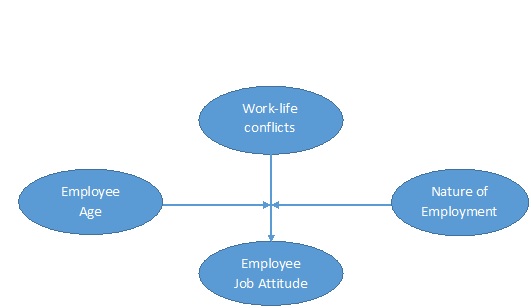
Figure 1.5.1
1.6 Overview of Methodology
The qualitative and quantitative research was carried out to investigate the relationship between the work-life conflicts and employee attitude. The primary data was collected from through interview and survey. 240 Chinese female employees participated in this study. The sample was divided into four groups. The participants of the first group were the young females and participants in the second group was middle-aged females. The participants of the third group were the enterprise female employees and the fourth group was the freelancers. The data collected from the first and second groups were used for proving the first hypothesis. Similarly, the data collected from the third and fourth group was used for testing the second hypothesis.
2 Literature Review
2.1 Causes of Work-life Conflict
Work-life conflicts are becoming the reason for stress in employees, not only female employees working in tight schedules but also the male employees. It has become challenging for female employees to maintain a balance between work and life owing to increasing competition in the workplace (Karkoulian, et al., 2016). There are many factors that control the degree of work-life conflicts commonly confronted by employees. Makela et al. analyzed the contribution of different factors to the development of work-life conflicts. The study focused on Finnish employees working in different countries to investigate the causes of work-life conflicts. The identification of context-related factors influencing the work-life conflicts provide a ground for devising work-life conflict resolution strategies (Mäkelä, et al., 2014). Although the study focused on expatriates yet, it is relevant to all types of employees.
The interaction of work and non-work activities give rise to conflicts. The crossover effects of work and life activities negatively influence the work as well as life. The multiple roles of a person and the spillover effect of life on work and vice versa become the cause of conflict (Lambert, et al., 2016). However, some studies have shown that the spillover facilitates the work or life in some ways. Some spillover effects of life enrich the work domain of a person. The restricted resources also contribute to work-life conflicts. For instance, the lack of time and energy restricts the ability of a person to fulfill the demands of work along with the demands of life.
The consumption of more resources for the work domain causes the depletion of resources to meet the needs of the non-work domain. The excess of resources facilitates the optimization of resources for work and non-work domains (Jiang and Shen, 2015). The lack of flexibility in work schedule and long working hours restricts the conservation of time and energy for the non-work domain.
The factors contributing to work-life conflicts can be divided into three main categories. The first category includes the work domain related factors which included the extent of flexibility in work schedule, organizational culture, job satisfaction, intrinsic motivation, managerial support and nature of work. The second includes the non-work domain related factors which include family, community, and demographics. The third category includes the individual related factors. These factors are solely based on personality traits, choices and decisions of individuals in the personal domain.
The demographic factors are the key influencers of work-life conflicts. The degree of work-conflict may vary with age, gender, income, and education. There is a significant contrast in intensities of work-life conflicts of males and females particularly, in developing countries where lack of resources increases the burden on individuals and demands investment of maximum time and energy for work-related activities (Yadav and Dabhade, 2014).
The work-life conflicts of global careerist have slightly different context. In addition to work schedules and demographic factors, the cultural differences emerge as a significant factor in work-life conflict. The expatriates often find it challenging to optimize their resources in different cultures. Furthermore, the gender roles in different cultures are different. This factor limits the ability of individuals to cope with work and life challenges. Eventually, the unfair distribution of resources for work and life paves the foundation of work-life conflict.
Adisa et al. analyzed the reasons of work-life conflict and its implications for the individuals. The amelioration of work-life conflict is imperative for increasing the employee satisfaction at the workplace and eventually, the productivity of employees (Adisa, et al., 2016). The work-life conflict has become a major issue of the twenty-first century as the urbanization and accelerated industrialization have changed the dynamics of work-domain (Cahill, et al., 2015). This study accounted for different contexts such as social, economic and cultural factors to analyze the causes of work-life conflicts. The comprehensive examination of the work-life interface in these contexts gives insight into a variety of reasons for work-life conflict.
The conflict in responsibilities of work and life changes the attitude of employees towards their work as well as non-work activities. The demands of different roles assumed by an individual change the perceptions, attitudes, and behavior (Kim, 2014). The degree of incompatibility of work with life also determines the attitude of employees towards their responsibilities. The females engaged in medical professions experience a relatively high degree of work-life conflict than the females engaged in less challenging professions. The medical professions fall in the ranks of demanding professions with long working hours and labor-intensive activities. It becomes challenging for a female with the medical profession to achieve a healthy integration of work and life (Berkman, et al., 2015).
2.2 Implications of Work-life Conflicts
The work-life conflict impacts the performance and participation of employees both at work and non-work domains. The reduced performance of employees owing to unhealthy work-life interface leads to the development of stress. The inability of employees to fulfill the expectations of different roles that they assume in the work and family causes frustration and further exacerbates the work-life conflicts. The female employees commonly face time-related conflicts while male employee confronts strain-related conflict. This implies gender roles also determine the nature of work-life conflict experienced by employees.
Although both the male and female employees are exposed to the risk of work-life conflicts yet, female professionals have a greater tendency to experience the work-life conflicts than males. The traditional roles of women in different cultures increase their responsibilities which influence their engagement in the workplace (AlAzzam, et al., 2017). Furthermore, the type of employment also determines the intensity of the work-life conflict. The people working in more competitive environments and engaged in competitive professions are more prone to work-life conflict. On the other hand, the people engaged in flexible working environments and self-employment are least vulnerable to work-life conflict.
Cloninger et al. analyzed the work-life conflicts from different perspectives. The study considered work-family conflict and family-conflict as two different perspectives. The interference of family in work can mediate the relationship between work and non-work domains (Cloninger, et al., 2015). This approach can mitigate the adverse effects of work-life conflicts on the job satisfaction, commitment, and attitude of employees. The study also considered the role of gender in controlling the intensity of the work-life conflict.
Work and family are two major components in the composition of human life. The boundary between work and non-work domains either impedes or facilitates the transfer of resources. The transition of individuals from the roles of work in the role of family and vice versa challenges the finite resources. The demanding professional roles facilitate the interference of work in the family. Similarly, the demanding life roles facilitate the interference of family in work. The reciprocally related work and family responsibilities cause drainage of resources from the work domain to family domain and vice versa. The reduced performance of employee at the workplace may cause the reduced performance of employee at non-work domains. This implies spilling of effects of work domain to non-work domain.
The management of resources to fulfill responsibilities in different domains of life can reduce the work-life conflict. However, it is challenging for employees to suppress the impacts of different factors that hinder the effective management of resources. The employees should focus on conserving the limited resources to avoid the adverse impacts of work-life conflicts. The individuals should emphasize the skills in non-work domains that could facilitate the accomplishment of goals in the work domain. The employees attributing their work interference in family experience a relatively higher level of job dissatisfaction. They perceive their jobs as the reason for their problems in non-work domains of life.
The perception of employees towards their work as a source of disruption of their family life diminishes their commitment to the organization. Similarly, the interference of non-work domain in the work domain increases the dissatisfaction of individual towards non-work domain (Chan, et al., 2016). The work and non-work domains of an individual compete for the limited resources. Sometimes the overconsumption of limited resources to satisfy the demands of one domain trigger the work-life conflict. Some studies have shown that the work activities do not explicitly impact the non-work domains of life. The indirect impacts of work-domain on family life also contribute to the work-life conflicts.
The perception of males and females towards their social roles determines either family is interfering in the work or work is interfering with the family (Drummond, et al., 2017). The social role of individual shapes the distribution of resources for work and non-work domains. The wage gaps and gender inequality, in some countries, further strengthens the work-life conflict. In the struggle to overcome the wage gaps and minimize the gender inequality, the females often work-life conflicts. The minimum autonomy of females and limited choices restrict the fair distribution of resources to avoid the conflicts.
2.3 Critical Analysis of Previous Studies
2.3.1 Role of Work Schedules and Supportive Environment
Henly and Lambert analyzed the implications of work schedules for work-life conflicts. The work timings are largely determined by the nature of the activities. In some professions, the timings of work for employees are highly unpredictable (Henly and Lambert, 2014). Contrary to it, the professions or jobs which have predictable work timings are less susceptible to work-life conflicts. This study focused on retail jobs and accounted for the female employed in retail jobs. The schedules of retail jobs in the United States of America are quite unpredictable which creates time-based conflicts for female workers. Furthermore, the work schedules are highly unpredictable for low-skilled labor engaged in retail jobs. This study provided into time-related issues of employees. These issued could also be confronted by the female employees in China.
The non-standard work hours invokes a sense of dissatisfaction among female employees in retail jobs. The unplanned activities reduce the ability of female workers to effectively participate in non-work domains. The precarious employment increases the challenges of low-skilled labor who suffers from the financial crisis and seek jobs that can stabilize their financial conditions. The uncertainty in work hours particularly, in temporary jobs, triggers the work-life conflicts (Mauno, et al., 2015). The variable-hour jobs exacerbate the interaction of work and life. Some organizations often force the employees for over-time which restricts their ability to meet family demand and eventually, the employees experience an imbalance in work and family.
Fiksenbaum collected data from over 100 employees in Canada to test the model designed to analyze different factors of work-life conflicts. The study considered vigor, absorption, and dedication as three different dimensions of employee engagement. Similarly, the study has taken managerial support, time and energy demands of organization and impacts of a career as three different dimensions of work-life culture. The perceived level of work-life conflicts is greatly influenced by the level of positive outcomes of work-life (Fiksenbaum, 2014). The work-life culture mediates the relationship between work-life conflicts and positive outcome of work-life. The positive outcomes of work-life imply the availability of programs that enhance the performance of the employee in the family or non-work domains. The availability of such programs improves the perceived level of job satisfaction of employees and make them more engaged and committed to their organization.
The supportive environment of the organizations facilitating the non-work roles of employees generates the positive outcomes of work-life interaction. The organizations have a significant role in shaping the work-life culture of employees. The managerial support provided to employees and specially designed work-life programs can improve the perception of employees to work and non-work domains (Agarwala, et al., 2014). However, there are only a few studies that focus on the mediating role of work-life culture. There is no strong evidence to support the strength of the role of work-life culture in the determination of work-life conflicts. The organizational support facilitates the employees to achieve balance in work and life rather than investing maximum resources at the workplace (Goh, et al., 2015).
2.3.2 Strain-and Behavior-related Conflicts
The preoccupation of employees with non-work issues at the workplace is referred to as strain-based conflict (Eby, et al., 2018). Similarly, the preoccupation with work issues at non-work increases the level of stress. The consumption of more time for the accomplishment of work-domain activities reduces the time for non-work activities and creates the time-based conflicts. The difficulty in behavior transition with the transition in roles negatively influences the effectiveness of an individual’s role in different domains. The practice of behaving inappropriately without accounting for the demands of different roles leads to the development of behavior-based conflict.
The perceived challenges of clinicians develop the work pressure and negatively influence the work-life balance. Mache et al. (2015) investigated the impacts of resources and workplace challenges on the work-life conflicts mediated by employee satisfaction at the workplace. The number of roles assumed by an individual in work as well as non-work domain impacts the engagement in both domains. The likelihood of work-life conflicts is greater in employees that more exposed to challenges work and life (Mache, et al., 2016). Similarly, the level of stress experienced by employees may vary with perceived challenges. The employees more engaged with their work feels more dedicated and committed to their work. The interference of non-work domain in the work domain negatively influence the work-related well-being of employees.
Some researchers contend that the work engagement moderates the work-life conflicts. The availability of surplus resources at the workplace allows the employees to meet the demands of their job without disturbing the balance of work and life. This implies that the stress and work-life conflicts are positively correlated (Ilies, et al., 2015). Contrary to it, the work engagement and work-life conflicts are negatively correlated. The workplace providing more opportunities for growth and development reduces the perceived level of stress of employees and facilitates the accomplishment of goals in domains of life.
2.3.3 Implications of Work-life Conflict for Psychological Health
Many studies have analyzed the relationship between work-life conflict and burnout. The burnout is a negative consequence of persistence of work-life conflicts (Pu, et al., 2017). The three key dimensions of burnout: emotional exhaustion, reduced professional accomplishment and reduced engagement at the workplace. The persistent detachment of employees at the workplace negatively influences their performance. The work-life conflicts trigger the development of emotional exhaustion accompanied by a reduction in engagement.
The unwillingness of employees to invest their time and energy reduce their commitment and motivation at the workplace. The reduced levels of employee engagement eventually, reduce the overall efficiency and productivity of the organizations. This implies a negative relationship between work-life conflicts and employee commitment or engagement towards work (Mas-Machuca, et al., 2016).
The difference in stress level on the basis of gender is mainly evident in healthcare professionals. The strength of different various factors such job demands, stress, resources and satisfaction may vary for different genders. Devi and Rani (2015) investigated the work-life conflicts experienced by women in the sector of information technology. The organizational stress may vary with the nature of industry it is operating in. The industry of information technology has experienced an increase in the female workforce. Contemporarily, more women than ever are participating in the information technology industry. However, the rapidly changing conditions in the IT industry has increased the demands of jobs. The juggling of women between work and family life have lowered their productivity significantly.
The challenges of distributing resources for paid as well as non-paid work have negatively influenced both work-related and non-work well being of females (Devi and Rani, 2016). The stress of multiple roles implies negative attitudes towards work and reduced performance. The stressful working conditions for females in different industries and increasing job insecurity have negative impacts on the competitiveness of women. The continuous efforts to improve and upgrade the skillset in accordance with the changing requirement of industries are increasing the intensity of work-life conflicts. The organizational stressors are positively associated with the work-life conflicts (Adisa, et al., 2016).
The work-life conflict is strongly associated with the anxiety and depression in different cultures. The anxiety and depressions are the some of the outcomes of work-life conflicts. There are some controversies in the literature on the impacts of work-life interaction on the intensity of anxiety and depression. Some studies have considered anxiety and depression as the response of employee to the work-life conflicts (Armstrong, et al., 2015). However, these studies are inconsistent with the findings of other studies which emphasize that anxiety and depression lead to the development of work-life conflicts. Some researchers argue that the nature of this relationship depends on the context of organization and employee. The cross-sectional construct of this relationship has led to controversies.
Nohe and Meier conducted an analysis to evaluate the nature of this relationship. The study aimed to reduce the controversies over the direction of this relationship. The study accounted for two perspectives of work-life conflicts and different aspects of strain to analyze the relationship. The cross-domain analysis has given insight into the reciprocal effects of this relationship. However, there is no strong evidence that either the work-life conflicts lead to the development of strain or the persistence of strain leads to the development of work-life conflicts (Nohe, et al., 2015). Moreover, the effect-recovery model supports the theory that work-life conflicts can lead to the development of strain (Marzuq and Drach-Zahavy, 2012).
The effect-recovery model suggests the relationship between the demand of job, workload and after effects of the workload in the form of strain. The recovery opportunities mediate this relationship. The control of the individual over a job or the availability of job opportunities allows the individual to control the consequences of work. The work potential of an individual is another dimension of recovery opportunities. The work potential determines the energy or capacity of the individual to bear the workload or pressure. The potential manifests the ability of an individual to cope with the stressors. The individual having more opportunities for recovery tend to avoid the strain. This implies high potential and recovery opportunities prevent the anxiety and depression, and increases the job satisfaction.
2.3.4 Impact of Work-life Conflict on Employee Satisfaction
The job satisfaction is one of the dimensions of employee’s attitudes towards their work. The perceived quality of life influences the behavior of employees towards the work and non-work domains (Colichi, et al., 2017). Previous studies have shown that the decline in perceived quality of life can result in reduced job satisfaction of employees. Eventually, the organizations experience an increase in the rate of turnover and absenteeism. Some studies have shown that detachment of employees with co-workers and punctuality problems are the consequences of a reduction in satisfaction of employees at the workplace. The employees perceive their work as unworthy and stressor for their non-work domain of life.
The stress-related outcomes of work-life conflicts are the key reason for reduced job satisfaction (Chen, et al., 2015). There are some factors that can control these stressors. The managerial support is one of those key factors which can either increase or decrease the perceived quality of an employee’s life. Goh et al. examined the relationship between the managerial support and employee satisfaction in the context of work-life conflicts. The study shows that the work-load or pressure is positively associated with work-life conflicts (Goh, et al., 2015). On the other hand, the work-life conflict is negatively associated with the life satisfaction of employees. The intervention of managerial support can reduce the intensity of work-life conflicts. The study accounted for the managerial support that specifically targeted the work-life issues.
The interference of managerial support for achieving the balance between work and family life makes a positive influence on the job satisfaction of employees (Rofcanin, et al., 2017). The managerial support intervention can occur in two ways. Firstly, the improvement in the perceived quality of the work domain of employees can reduce the perceived stress as the result of high work-loads. The supervisors can participate in the improvement of the work-related well-being of employees. Consequently, the employees overlook the stressors and perceive its work as worthy. This aspect of managerial intervention can suppress can impacts of stressors at the workplace.
The second aspect of managerial intervention is the informal support to achieve the work-life balance. The managerial support can significantly influence the interaction of work and life. The supervisory support moderates the relationship between the work-life conflicts and the job satisfaction of employees (Odle-Dusseau, et al., 2016). However, some studies have shown that the strength of this implicit relationship is not strong as there are many other factors that control this relationship. The mediation effect of managerial support is coupled with many stressors which influence the work-life interface.
Various studies have moderated this relationship with different aspects of culture. The norms and values of different cultures influence the relationship between work-life conflicts and job satisfaction of employees. Haar et al. analyzed the moderating role of culture in the dependency of employee satisfaction on the work-life conflicts. The study accounted for the individualism, collectivism and gender egalitarianism as the dimensions of culture. Some studies have related the work-life conflicts to conflicts in roles. The cultures having high role conflict are more vulnerable to work-life conflicts. Contrary to it, some studies have considered the uniqueness of the characteristics of work-life conflicts for each individual.
Each person differently approaches the work-life conflicts. This influences the perception of each individual towards the quality of life. The norms and values of different cultures determine the work and non-work related roles of an individual. Similarly, the demands of different roles are influenced by the cultural values. The challenges in harmonizing the work and non-work commitments negatively influence the responsiveness of employee to the work. The individualistic societies facilitate the achievement of work-life balance and enhance the satisfaction of employees as there are more opportunities to harmonize the work-life interface. Similarly, the societies with more gender equality have reduced rate of work-life conflicts and greater job satisfaction (Haar, et al., 2014). On the other hand, the societies with minimum gender equality cause depletion of resources to meet the demands of multiple roles.
2.3.5 Impact of Work-life Conflict on Employee Engagement
The dynamic demands of work can influence the work-life interface either implicitly or explicitly. The continuously varying intensity of work pressure threatens the co-existence of work-related activities with the non-work domain. It impacts the engagement of employees towards the organizations. In addition to employee engagement culture of an organization, the work-life conflicts also influence the attitude of employees towards the interests and goals of an organization. The intensity of work-life conflicts determines how much an employee invest the effort to achieve the organizational goals. Shankar and Bhatnagar developed a model to examine how work-life conflict is associated with the engagement of employee at the workplace. The study also considered the impact of work-life conflict on the emotional well-being of employees and how it relates to turnover.
Many studies have shown that the work supervisors or top management of the organization emphasize reducing the work-life conflicts among employees to improve their engagement. The managerial support focused on the emotional well-being of employees reduces the emotional dissonance which is the main cause of turnover intention among employees confronting the work-life conflicts (Shankar and Bhatnagar, 2010). The emotional consonance develops the sense of satisfaction in employees and reduces the chances of a turnover. Some researchers contend that the work-life conflicts do not impact the emotional consonance. However, some studies provide a strong evidence that the emotional consonance mediates the relationship between work-life conflicts and employee engagement.
The emotional dissonance is conflict in experience and expression of emotions. Sometimes, the shortage of resources for different roles culminate in conflicts. Eventually, the discretion of employees reduces. This scenario increases the contrast in emotions experienced by the employee and the emotions expressed by the employee in order to show the commitment. This forced commitment negatively influences the job satisfaction. The persistence of emotional dissonance for a long time can increase the rate of turnover.
The work-life conflict is a subjective experience and it is difficult to measure to which extent it can influence the emotional consonance of employees. Similarly, it is challenging to measure the level of employee engagement and turnover intention influenced by the intensity of work-life conflicts. The subjectivity of work-life conflicts can be reduced by using different mediators. However, there is no such research which studies this relationship from the perspectives of multiple mediators. Different studies have emphasized the role of different mediators. This approach has increased the inconsistencies in results.
2.3.6 Work-life Enrichment and Self-Efficacy
There is a controversy that either work-life interaction has negative spillover effects or there are some spillover effects which positively influence the life of employees. The positive spillover effects of work-life interaction enrich the work and non-work domains of life. These effects enhance the effectiveness of employees in both domains (Kim, 2014). The experiences of one domain can improve the performance of employees in the other domain. The enrichment of non-work domain under the influence of work-domain facilitates the emotional consonance. Eventually, the emotional consonance facilitates the engagement of employees towards the organization. It shows not only a positive association between work-life conflict and emotional dissonance, also a negative association between employee engagement and emotional dissonance.
Some studies have emphasized the role of work-life conflicts as the mediator of the relationship between the enrichment of work and non-work domains. This role of work-life conflicts address the controversies in the relationship between work-life conflict, job satisfaction, and strain. Chan et al. (2015) investigated how the job satisfaction of employees is influenced by the enrichment of work-life interface and mediated by work-life conflicts and self-efficacy. This study has accounted for the cognitive abilities of employees to moderate this relationship. The self-efficacy of an individual makes a major contribution to the satisfaction of employees.
The social cognitive theory suggests that the behavior or attitude of the individual is greatly influenced by the external environment. The observation is a major part of the learning process. The social experiences and interaction shape the behavior of an individual. The self-efficacy of the individual is an aspect of cognitive abilities. The self-efficacy determines the behavior of individual towards a specific task and challenges (Schwarzer, 2014). It defines how an employee perceives its abilities to handle a particular situation or to deal with the workplace challenges. The self-efficacy shapes the confidence of employees towards accomplishing a task at the workplace.
The high self-efficacy of an employee reflects its abilities to yield the desired results at the workplace. The high self-efficacy improves the performance of employees at the workplace and eventually, develops the job satisfaction (Chan, et al., 2016). The enrichment of the work domain as the outcome of activities in the non-work domain and vice versa increases the self-efficacy of an individual. This facilitates the achievement of balance in work and life. Some studies have argued that the work-life conflict is strongly associated with the cognitive resources of employees. The work-life enrichment has implications for the behavior-based conflicts in the interaction of work and non-work domains.
The work-life enrichment changes the perceptions of employees both towards work and non-work domains. It tends to motivate the employees to accomplish the challenge tasks. It facilitates the successful transition of roles in work and non-work domains. However, the continuous changes in the external environment of employees can influence the self-efficacy and eventually, exacerbate the work-life conflicts. The bidirectional spill-over of effects at the permeable boundary of work and life changes the intensity of work-life conflicts and job satisfaction (Yadav and Dabhade, 2014). The employees experiencing a high level of satisfaction in all assumed roles tend to avoid the imbalance in work-life. The reduction in inter-role conflict enriches the work-life interface and maximizes the employee engagement.
2.3.7 Impact of Work Arrangements of Work-life Conflict
The improvement in working arrangements can make a positive impact on the attitude of employees. The job satisfaction, turnover intention, and engagement are the reflection of the attitude of employees. These are the measures of behavior or responsiveness of employees towards their work. The work-life interface is highly sensitive to the work arrangements. The minor changes working conditions or arrangement implicitly influence the work-life conflicts. This influence is reflected in the attitude of employees. Timms et al. (2015) investigated the impact of work arrangement on different aspects of the employee engagement. The study also accounted for the mental health of employees as the variable to measure the influence of work arrangements.
The organizational culture plays a significant role in shaping the work arrangement of an organization. The flexible work arrangements facilitate the employees to meet the responsibilities of different roles (Timms, et al., 2015). It enables the employees to optimize their resources to satisfy the demands of diverse roles. However, the findings of some studies are inconsistent with the impact of work arrangements on work-life conflict and eventually, employee engagement. Some studies argue that work arrangements are not a significant factor that influences the employee engagement and mental health of the employee. However, there is a strong evidence that the norms and values of an organization greatly influence the employee engagement.
Some studies suggest that the prevalence of supportive cultural values in an organization increases the utility of flexible work arrangements. The employees working in flexible conditions and supportive culture are least prone to the development of stress and work-life conflicts. The flexible work arrangements favor the integration of work and non-work domains without depleting the resources of employees for different responsibilities (Galea, et al., 2014). The flexible solutions at the workplace prevent the exhaustion and enhance the ability of employees to perform effectively in all domains. Consequently, the employees feel more satisfied with their work and family lives. The participation of the organization in achieving the work and life balance increases the emotional and mental attachment of employees with organizations and colleagues.
The part-time work is another dimension of work-arrangement. In some countries, the part-time work increases the work-life conflicts. However, there is no strong evidence supporting the role of external conditions such as government policies in the development of work-life conflicts in the context of part-time work. Some studies have suggested that the part-time work has no significant impact on the work-life conflicts. The study of Roeters and Craig suggest that the part-time occupations in Australia, UK, Germany and Netherlands positively influence the work and life balance. This stimulates the job satisfaction of employees as the government policies in these countries protects the rights of part-time workers (Roeters and Craig, 2014). This practice has increased the participation of employees in part-time occupations in these countries.
2.3.8 Impact of Age on Work-life Conflicts
The life-stage of an employee determines how he or she perceives the intensity of work-life conflicts. In addition to it, the level of interference of work into the family and vice versa change over the course of life. As the experiences of roles change at different stages of life, the influence of work-life conflicts may vary. The perception of employees towards their roles also changes with time. The employees of different generations may view themselves in different roles quite differently. The stage of development can change the perspective of employees towards their jobs. Allen and Finkelstein examined the role of age and gender in the development of work-life conflicts. However, there is no strong evidence that which age and stage of development are more vulnerable to the risk of work-life conflicts.
The stage of development defines different roles that would be assumed by an individual at that particular stage of life. The evolution of different roles is often accompanied by the increase in demands which could be in conflict with the demands of work (Allen and Finkelstein, 2014). The study has analyzed the different stages of development to examine its impacts on the work-life conflicts. The nature of issues, challenges, priorities, and roles are different at every stage of life. However, this study has not merely analyzed the work-life conflicts in the context of age. It has also considered the gender as a significant influence of this relationship. The results of this study demonstrated that at the stage of establishment, the work-life conflict is minimum as the individual experience low level of interference of work into non-work and vice versa.
Bennet et al. (2017) analyzed the experience of work-life conflicts in different generations. The study collected the data from 428 employees that belonged to different generations and was at different stages of development. The study analyzed both work-family and family-work conflicts for each generation. The results demonstrated that the baby-boomers experienced minimum work-family conflicts while maximum family-work conflicts (Bennett, et al., 2017). The findings have shown that the millennial is the work-centered which increases their work-family conflicts.
The work-life conflict is the major influencer of job satisfaction, commitment, and engagement of employees. The employment of stress-coping strategies and intervention of managerial support can reduce the work-life conflicts and improve the attitude of employees towards their work. The organizations can transform their organizational culture to facilitate the work-life balance. The organizations should focus on the training of young female employees to achieve the balance between work and family. Furthermore, the government can introduce the regulations to reduce the time-related conflicts.
2.4 Research Hypotheses
Hypothesis 1:
Young female employees’ job attitudes are more likely to be influenced by work-life conflicts than middle-aged female employees.
Hypothesis 2:
Female enterprise employees’ job attitudes are more likely to be affected by work-life conflicts than female freelancers.
3 Methodology
3.1 Research Philosophy
The philosophy of this study is positivism. The research is made on the basis of factual data. The quantifiable data is collected through survey and interview. The deductive approach is employed to conduct this study. The positivism research facilitates the statistical analysis of data. It helps in carrying out independent research to investigate a specific phenomenon. The empirical evidence collection is basic principle of this research methodology. It supports the testing of hypothesis with minimum level of error.
3.2 Setting
This study focused on investigating the impact of work-life conflict on the attitude of female Chinese employees. The first hypothesis of this study implies that the attitudes of young female employees are relatively more influenced by the attitude of middle-aged female employees. The age of female employees is one of the dimensions of demographics which was studied in this research. The second hypothesis of this study accounted for the nature of employment to investigate the impact of work-life conflicts on the female employees. The combination of quantitative and qualitative methods was used. This study was carried out in China and targeted female employees working in different industries.
3.3 Sampling
This research focused on female Chinese employees to investigate the impact of work-life conflicts on female employees of different ages and belonging to different professions. The population of this research was the Chinese females. The sample size for testing both hypotheses was 120 each. The random sampling technique was used to select the participants of this research. The random sampling method increased the internal validity of this research. A random number generator selected a participant from the targeted population for the sampling.
The participants of this research were divided into two groups (Group A and Group B) to collect the data for the testing for the first hypothesis. This division was made on the basis of age. The females of one group are relatively younger than that of the second group. The first groups (Group A) consisted of about 60 Chinese female employees belonging to age groups of 25 to 35 years working in different settings. The second group (Group B) consisted of Chinese females with age ranging from 35 to 45 years. All females worked in different industries including bank clerks and white-collar females.
Similarly, the sample population for the second was divided into two categories (Group C and Group D). The first category (Group C) included the Chinese females working in different enterprises and belonging to the age group of 25 to 35 years. The participants of this group were mainly from banks and high-tech companies. The second category (Group D) included the Chinese females working as freelancers. The female freelancers selected for the sample were mainly café owners, internet celebrities, and store owners. The division of population in two categories was imperative to cover the focused areas of research questions.
3.4 Procedure
The data was collected through interviews and survey for testing of the first hypothesis. A questionnaire for the interview was made which included a variety of questions. The questions were designed on the basis of research questions to collect the relevant information. The questions focused on investigating different aspects of experiences of the participants related to work-life conflicts. The interview questions were within the ethical boundaries and did not focus on exploiting the personal information of the participants. The response of participants to the interview question provided the qualitative data for the analysis.
The interview was conducted in groups. For data collection to test the first hypothesis, each group for interview consisted of 2 young female employees (Group A) and 2 middle-aged female employees (Group B). The interviewing team carefully recorded the response of each female in the group to synthesize a collection of accurate data. There were total seven interview questions that aimed at investigating the feelings, experiences, and opinions regarding work-life conflicts and how these conflicts influenced their attitude to the job. The response of the participants was recorded in video format. For the survey, the questionnaires were sent to over 200 participants by email or social APPs.
Similarly, the interview group for data collection of the second hypothesis consisted of two females (Group C) working in enterprises and two females (Group D) working as freelancers. Same interview questions were used for these groups. The interview allowed the researchers to limit the data within the scope of the selected variables. The questionnaire included both close-ended and open-ended questions which increased the ease of collecting relevant data. The questionnaire was sent in the online format to over 200 Chinese female employees. This method of data collection provided the opportunity to collect accurate data to accept or reject the hypothesis. It enabled the researcher to directly interact with the participants.
Applications were submitted to the concerned authorities of all organizations to get the formal permissions for the conduct of study. Similarly, the formal permission was taken from the participants of interview and confidentiality of their identity was ensured. The data collected from interview and survey was stored in electronic format at the reliable storage electronic storage facilities.
3.5 Data Analysis
As discussed earlier, four different groups for two hypothesis were formed. The data was analyzed separately for each group. The response of each participant was recorded against each question. Both qualitative and quantitative analysis tools were used to analyze the tabulated data.
The data was displayed in the format of different graphs for the further analysis. The graphical representation of data provided the clear insight into different variables of the study. Finally, the relationship between different variables was developed. This relationship formed the basis for the acceptance or rejection of hypotheses. The graphs represented the data for four different groups. After critically analyzing the graphs, the proposed hypotheses were tested.
Firstly, the data of the first two groups were evaluated to analyze whether the proposed relationship of work-life conflicts, age and job attitudes is true or not. Similarly, the data of third and fourth groups are evaluated to check whether the proposed relationship of work-life conflicts, nature of employment and attitude is true or not. After testing the hypothesis and critically analyzing the data, appropriate conclusions were drawn from the results.
4 Results
4.1 Interview Results
4.1.1 Results of Group A
The first research question investigated the influence of parents on the job choice of the participants and whether they perceive this as conflict or not. About 60% of the participants responded that their job choice has been influenced by their parents and consider it as the conflict. The influence of parents on the job choice of females is a dimension of work-life conflicts. This influence limits the career options for females. In such scenarios, the females perceive themselves as unable to exploit the opportunities of growth and development. This practice has restricted the females to adopt only a few career paths which are in accordance with the desires of their parents.
The second question investigated whether the participants ever thought of resigning from their jobs to take care of husband and children. About 50% replied that they have considered the option of resigning owing to their multiple roles at family and work. The roles of females in a non-work domain often demands the extra investment of time and energy. When they feel unable to fulfill those needs, they opt to leave their career and focus on the meeting the needs of non-work roles. The participants of this group have experienced these feeling many times in their life. They believe that changes in priorities greatly influence this experience.
The third question focused on the effects of bad experience of work on the non-work domain. About 70% of the participants responded that non-work domain of their lives was influenced by challenges at the workplace. They opinionated that their reduced performance at the workplace or bad experiences in work-related activities influenced the effectiveness of their roles in non-work related activities. Sometimes, the bad experiences at the workplace lead to the development of emotional exhaustion in females. This exhaustion from work domain spills to the non-work domain of females. Eventually, the females experience exhausted in non-work domains. The Chinese females of this group have frequently experienced these feelings at different stages of their career.
About 80% of the participants think that the interference of work in the non-work domain is the work-life conflict. Others think that the inability of an individual to cope with challenges of work and non-work domains owing to multiple roles and lack of sufficient resources such as time and energy are the reason for work-life conflicts. The personal definitions of work-life conflicts varied from one individual to other. Some experiences were perceived as work-life conflicts by some participants while others perceived them as workplace challenges. However, there were some common experiences that were considered as work-life conflicts by all participants.
The examples of work-life conflicts reported by the participants included timing- and energy-related issues. The unpredictable work timings in some organizations reduced the time to meet their obligations to the non-work domain of life. The tight schedules and working arrangements restricted their ability to cope with other challenges. Sometimes, the family-related issues interfered in the work and forced them to opt for alternative career paths. Some participants reported that compulsory overtime in some companies exhausted them frequently.
Approximately 80% responded that the work-life conflicts have negatively influenced their attitude to the job. Most participants reported that the work-life conflicts reduced the perceived worth and quality of their work. They attributed their work as the reason for the negative experiences in the non-work domain. The persistence of work-life conflicts reduced their interests in work. The experienced decline in their dedication and absorption in work. They often confronted the challenges in engaging with work-related tasks. The increasing complexity of work-life conflicts negatively influenced their commitment to the accomplishment of goals with work. Furthermore, owing to the high intensity of work-life conflicts, they felt least satisfied with their jobs.
Approximately 70% opinionated that the negative attitude to job reduced their efficiency at the workplace. The reduced efficiency at the workplace is the potential outcome of reduced job satisfaction and minimum engagement. The participants opinionated that the work-life conflicts had indirectly influenced their efficiency at work. The lack of resources restricted their ability to perform at their maximum potential. The lack of commitment reduced their performance. Some consider that the work efficiency and work-life conflicts are strongly associated while others thought that the work-life conflict is not the only factor to influence their efficiency.
Approximately 40% believed that the measures taken to deal with the influence of work-life conflicts are effective. Other think that these measures make no significant contribution to reducing the intensity of work-life conflicts. Some participants reported that they had not taken any significant measures to minimize the negative impacts of work-life conflicts.
Some reported that they have adopted the measures to mitigate the work-life conflicts yet, this practice had not yielded the desired outcomes. Despite adopting different strategies to deal with work-life conflicts, the participants confronted a challenge in maintaining their engagement at work. These measures remained ineffective in changing the attitude of the participants to work-related activities. However, some suggested that the participation of colleagues and family members can increase the effectiveness of these measures. Furthermore, the suggestions of females belonging to the banking industry were quite different from the females working in the high-tech industry.
4.1.2 Results of Group B
About 50% of respondents to the interview in Group B responded that their career choices are influenced by their parents and they thought that it was a kind of work-life conflict. As discussed earlier, the females of this group belong to the age group of 35 to 45 years. The career choices of females of this group were relatively less influenced by the parents.
Approximately 40% of participants responded that they have thought of leaving the jobs to meet the demands of roles in the non-work domain. The females of this group reported that on many occasions in their lives, they had considered the option of leaving their jobs or switching to different career paths owing to the family problems. Sometimes, their family issues demanded more time and energy. In such scenarios, it was challenging for them to continue their jobs. They opinionated that the work-life conflicts forced them to leave their jobs.
Approximately 60% replied that their lives have been influenced by some bad experiences in the workplace. The females of this group reported that workplace challenges indirectly influenced their non-work domain of life. The issues at the workplace negatively influenced their mental health and eventually, reduced their performance in other activities. Sometimes, the behavior-based conflicts created challenges for the performance in accordance with the demands of different roles.
About 20% failed to give any significant example of the personal experience of work-life conflicts. Most examples of work-life conflicts reported by females were related to family issues. About 80% reported that they often juggle between work and family. They believed that the permeability of the work-family boundary for females is relatively higher than for males. The higher susceptibility of females to work-life conflicts negatively influenced their life satisfaction.
Approximately 60% believed that they had experienced negative effects of work-life conflicts on their attitude to the job. Most females have experienced the drastic decline in interest at the workplace. The bidirectional interface reduced their commitment to work. Instead of enriching their non-work domains, the work-related activities
About 70% responded that they have experienced a reduction in their efficiency at workplace owing to work-life conflicts. The females of this group felt that the negative attitude towards their work negatively impacted their efficiency. However, some participants experienced the challenge of evaluating the impact of work-life conflicts on their efficiency.
About 50% opinionated that the measures to avoid the adverse effects of work-life conflict are effective. Some participants reported that they experienced problems in identifying the coping strategies to avoid the work-life conflicts. Furthermore, despite implementing the strategies, they persistently experienced the negative impacts on their performance.
4.1.3 Results of Group C
Most participants reported that they have experienced the influence of their parents on their choice of the job but they did not consider it as the work-life conflict. They opinionated that this influence is not significant a type of interference of non-work domain in the work domain. About 60% reported that they thought of quitting their jobs to increase the effectiveness of their performance in non-work roles. They believed that the key reason was the inter-role conflict which forced them to consider the alternatives.
A significant number of the participants of this group thought that they had been affected by bad experiences in the work-related activities. There were some issues that were common to all participants. However, the females employed in different industries had experienced varying level of influence. It was observed that some professions have a quite high permeability of work-life boundary which increases the influence of work-related on the non-work domain and vice versa.
According to most participants, the work-life conflict is the form of interference of work-related activities into the non-work domain. Eventually, they experienced reduced performance in both domains. The participants engaged in some professions opinionated that work-life conflicts changed their perception of their work. They perceived their work as unworthy and insignificant. The felt least satisfied with their jobs as well as their life. The reduced engagement at the workplace and the negative impacts of conflicts on psychological health reduced their efficiency. They felt less obliged to perform their duties at the workplace. The minimum job satisfaction restricted their ability to invest maximum efforts for the accomplishment of work-related activities.
Most participants responded that they were not aware of the strategies to make an appropriate response to work-life conflicts. However, their first response was to minimize the interference of both domains. Some participants started with prioritizing the tasks and others sought the interventions such as managerial and family support to resolve the work-life conflicts. Furthermore, they felt that these measures did not completely resolved the work-life conflicts but reduced their impacts on their efficiency to some extent.
4.1.4 Results of Group D
The participants of this group were the freelancers and entrepreneurs, and they reported that they experienced the minimum influence of their parents on the choice of career. A small percentage of the participants of this group reported that their family issues created the hurdles in pursuit of their selected career paths. They had rarely considered quitting their careers to address their family issues. Most participants have experienced the issues or challenges at the workplace that influenced their lives. However, they felt that these issues were not significant enough to influence their efficiency. It goes without doubt that had experienced the reduced efficiency on a temporary basis.
The participants of this group believed that the interaction of multiple roles and spillover of effects to the different domains of life created the work-life conflicts. However, these conflicts had not largely influenced their attitudes toward jobs. Eventually, they experienced a high level of satisfaction in the workplace. In addition to it, their work efficiency is least influenced by the interference of work into non-wok domains. To deal with the work-life conflicts, the participants of this group tried different strategies. For instance, most females modified their work-routines in accordance with their non-work domains. They clarified their duties and fairly distributed their resources to manage the work and non-work activities. They reported that these measures were quite effective and reduced their work-life conflicts to the maximum extent.
4.2 Survey Results
4.2.1 Results of Group A
About 30% of the participants responded that they chose their current job owing to the personal interests. About 40% reported that their family members forced them to choose the jobs that they are doing now. Others reported that the attractive salary packages and incentives were the reason for choosing their current job.
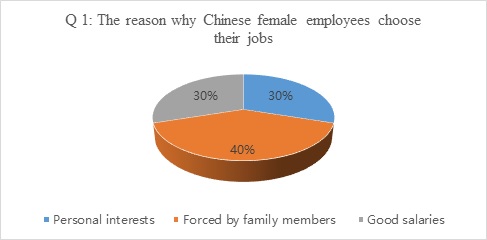
Figure 4.2.1.1
About 50% opinionated that they felt too much work responsibility towards their current job. Approximately 30% reported that they have too much work to do at their current job. About ten percent responded that the work demand of their current job is reasonable. Others believed that their current job was too easy for them.
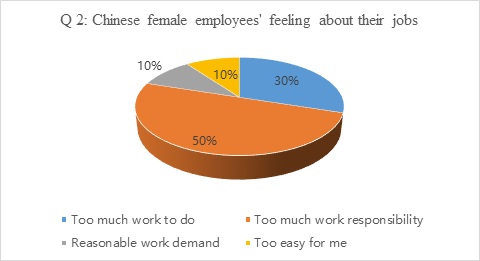
Figure 4.2.1.2
About 70% rated the conflict between work and family demands at 8 on the scale of 0 to 10. Similarly, about 80% rated the interference of job situation with family life at 7. Approximately 70% rated the experience of insufficient time and energy for both work and family at 8. About 50% rated the experience of interference of family situation in the job at 9. About 60% rated the experience of limited time for family responsibilities at 6. About 80% rated the experience of imbalance between work and family time, and negative opinions from family members for their job at 8.
About 50% reported that the experience of work-life conflicts have influenced their attitude towards the job and reduced their working efficiency. About 10% responded that they have considered the idea of resigning or changing the job. About 15% opinionated that the work-life conflicts reduced their morale to do their job. A quite small number of the participants reported that the work-life conflicts had made no obvious impact on their working efficiency.
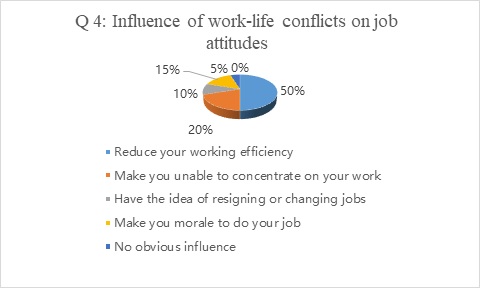
Figure 4.2.1.3
About 50% of the participants resigned or changed their job to deal with the work-life conflicts. Approximately 30% indulge in recreational activities or start working harder to reduce the perceived pressure of work and non-wok domains. Merely 10% sought the external help to resolve the work-life conflicts. Similarly, only 10% ignored the work-life conflicts which were continuously influencing their efficiency at work domain.
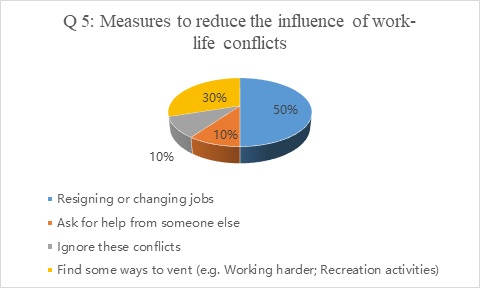
Figure 4.2.1.4
4.2.2 Results of Group B
About 50% of the participants reported that they have chosen their current jobs owing to attractive compensation. About 30% responded that they were doing their current jobs owing to their personal interest. Approximately 40% believed that the demands of their current job were reasonable. About 30% responded that the work responsibility of their current job was quite high. Merely 10% believed that their jobs were quite easy for them.
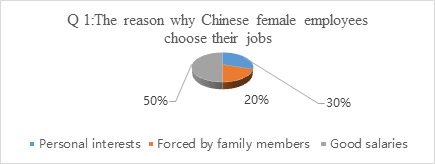
Figure 4.2.2.1
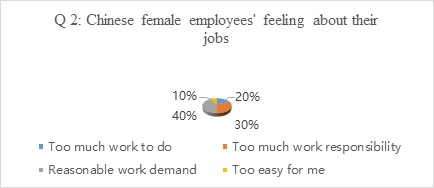
Figure 4.2.2.2
About 60% ranked the conflict between work and family demands at 8 out of 10. Approximately 70% ranked interference of job-related activities into the family life at 7. About 60% rated the feelings of insufficient resources at 8. About 50% rated the experience of imbalance between work and family at 7. About 40% rated the experience of insufficient salaries and negative opinions from family members at 6.
About 40% reported that the work-life conflicts reduced their efficiency at the workplace. Approximately 30% believed that the work-life conflicts have no significantly influenced their work efficiency. However, 10% believe that work-life conflicts have significantly influenced their concentration and morale at the workplace.
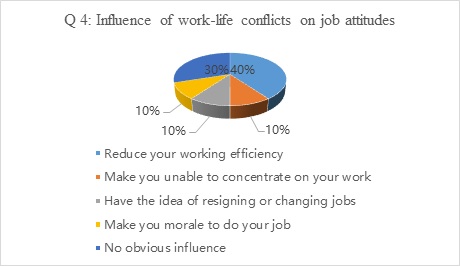
Figure 4.2.2.3
About 50% responded that they have found some ways such as recreational activities to vent out the depression and anxiety as the result of work-life conflicts. About 20% reported that they have thought of resigning or changing the jobs. About 20% of the participants asked for help from colleagues and family members to address the work-life conflicts.
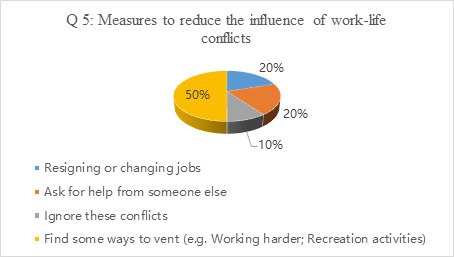
Figure 4.2.2.4
4.2.3 Results of Group C
Most participants of this group reported that they were pursuing their careers for their personal interest. About 30% opinionated that they were forced by family members to choose their current job. Similarly, 30% reported that they were doing their current jobs owing to good salaries. About 60% felt that they have too much work to do at their current job. About 30% felt that they have too many obligations to their work. Only 10% believed that their work was too easy for them.
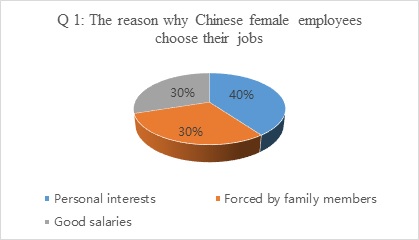
Figure 4.2.3.1
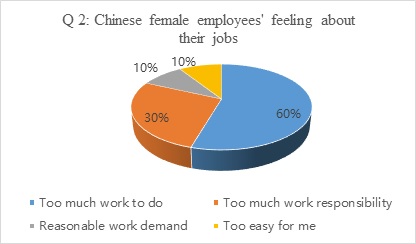
Figure 4.2.3.2
Most participants rated the conflict between work and family demands, interference of job in the family, interference of family in the job, lack of resources, an imbalance in work and family, and insufficient salaries at the range of 7 to 9. About 50% felt that their efficiency has reduced owing to work-life conflicts. None of the participants believed that the work-life conflicts have not influenced their work efficiency.
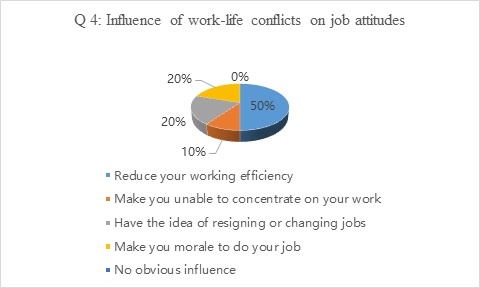
Figure 4.2.3.3
About 60% of the participants opted for resigning and changing the jobs to mitigate the impacts of work-life conflicts. Only 10% explored the alternatives to resolve the work-life conflicts. Similarly, 10% asked for external help to deal with the work-life conflicts.
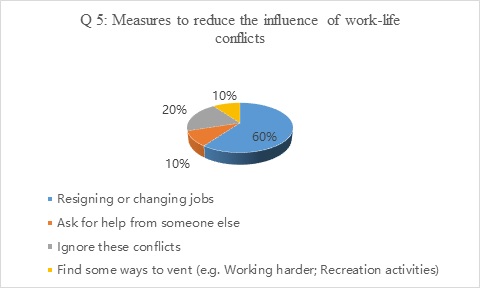
Figure 4.2.3.4
4.2.4 Results of Group D
About 70% reported that they were personally interested in their current job. Only 10% were doing this job as the result of the influence of family members. About 20% believed that the attractive salary was the reason for selecting their job. Approximately 40% felt that their current job have too much work responsibility. Only 20% believed that the work demand of their current job was reasonable.
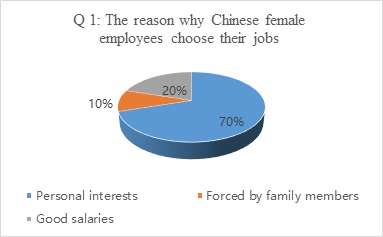
Figure 4.2.4.1
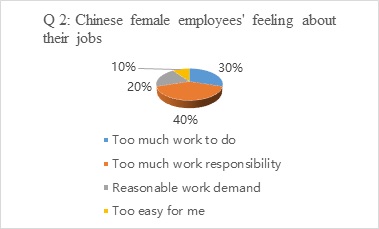
Figure 4.2.4.2
Approximately 50% rated the conflict between work and family demands at 6. About 60% rated the interference of work into family and family into work at 7. About 80% rated the insufficient time and energy for work and non-work at 5. Over 70% rated the experience of limited time and negative opinions from family members at 4.
About 40% experienced the negative influence of work-life conflicts on the work efficiency. Approximately, 20% felt that they were unable to concentrate on their work owing to work-life conflicts.
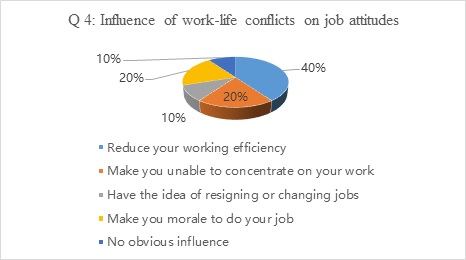
Figure 4.2.4.3
Merely 10% experienced the idea of changing or resigning from their current jobs. About 40% found the ways or strategies to resolve the work-life conflicts. Similarly, 40% took the assistance of surrounding people to reduce the work-life conflicts. Only 10% changed or resigned the current job to diminish the influence of work-life conflicts. Others preferred to ignore the work-life conflicts and focused on their work-related activities.
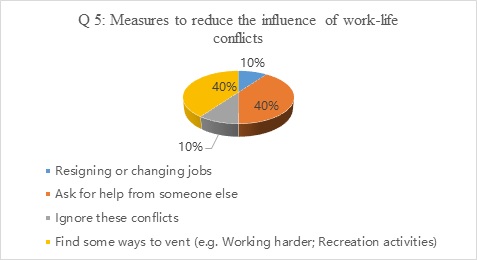
Figure 4.2.4.4
4.3 Discussion
4.3.1 Differences between female employees from different ages
The interview and survey results of Group A are in contrast with that of Group B. The young females are greatly influenced by the parents for making their career choices. On the other hand, the middle-aged females are more independent in making a decision regarding their careers. The young females confront challenges in achieving the balance between work and family. They perceive their responsibilities in family roles as more demanding. Furthermore, young females face problems in dividing their time and energy for different domains.
Commonly, the unfair distribution of resources led to the work-life conflicts. Contrary to it, the middle-aged females are more aware of the distribution of resources. This scenario enables the middle-aged females to overcome the work-life conflicts. These females rarely experience the feeling of resigning or considering the other options to fulfill their obligations to husband and children. The young females experience the relatively greater influence of bad work-related experiences than the middle-aged females. The spillover of work-related activities into the non-work domain hinders the accomplishment of goals at the workplace. Eventually, the young females feel relatively less satisfied towards their work than the middle-aged female who perceive less pressure and workload at the workplace.
The young females tend to experience the feelings of resigning or switching the jobs. The high susceptibility of young females to the work-life conflicts culminates in the reduced interest in the current job. The young females believe that by changing their jobs, they may be able to reduce the work-life conflicts. Contrary to it, the middle-aged females tend to resolve the work-life conflicts rather than changing their jobs. The key reason for this behavior is the perception towards work pressure. The young females experience more negativity in their attitude owing to the persistence of work-life conflicts over a longer period.
The work-life conflicts greatly influence the morale of female employees at the workplace. A quite small percentage of young females are capable of resisting the negative influence of work-life conflicts. The middle-aged females tend to adopt the strategies to minimize the work-life conflicts. For instance, they learn to conserve the resources and strive to consume the resources according to demands of each role rather investing more resources on one fulfilling the responsibility of a single role. The middle-aged females are more capable of minimizing the inter-role conflict by clarifying the duties. This proves the hypothesis that the young female employees’ job attitude is more likely to be influenced by work-life conflicts than middle-age female employees.
To achieve the balance between work and non-work domains, it is imperative to minimize the spillover of effects from each domain. This largely depends on the ability of an employee to control the work-life interface. The employees who are absolutely capable of controlling the work-life interaction tend to avoid the work-life conflicts. Similarly, the employees capable of successfully transitioning the roles tend to reduce the influence of work-life conflicts on their working efficiency.
The continuous work-life conflicts cause the loss of interest and disengagement at the workplace. This implies the negative association between work-life conflicts and employee engagement at work. This is accompanied by a reduction in job satisfaction and detachment. The continuous transition of roles creates an imbalance in the distribution of time and energy in the work and non-work domains of female employees. The shortage of resources for the female employees creates challenges in the switching of roles. This culminates in strain-based conflicts in young female employees. This implies a strong positive association between the work-life conflicts and attitude of young female employees.
4.3.2 Differences between different employment nature
The age of Chinese female employees who were the part of this research was the critical factor. The females of different age groups experience different problems and different intensity of work-life conflicts. The relationship of work-life conflicts and attitudes of the Chinese female employees is mediated by the age. In addition to the age of female employees, the nature of employment also determines the extent of influence of work-life conflicts on the attitudes of female employees.
The nature of employment includes the working arrangements, timings, job demands and type of organization. Some professions are more demanding and labor-intensive. Similarly, some professions have unpredictable work hours and tight schedules. The former category of profession demands more energy whereas the latter category demands more time. However, there are some professions which demand both the time and energy. The management of time and energy becomes challenging for females engaged in those professions. For instance, the females working in medical and retail professions have challenges in managing both the time and energy.
For this research, the nature of employment is classified into two groups. The first group of female participants was employed in enterprises operating in different industries. The second group was self-employed and run their own businesses in different industries. The self-employed or freelancer females are relatively less influenced by the work-life conflicts than the females employed in enterprises. The females employed in high-tech companies tend to change their jobs. The inter-role conflict and changing demands of workplace reduce their commitment. For instance, many participants in this research reported that they often have to take their work home as the result of a high workload.
Some females report that they often remain occupied with the family issues in the workplace. Eventually, they experienced the reduced concentration at the workplace. The inflexible work arrangement serves as the facilitator of work-life conflicts. Sometimes, the tight schedules hinder the optimization of time and energy for multiple roles assumed by females. Furthermore, the organizational culture increases the permeability of work-life interaction. It hinders the transition from one to another leading to the development of work-life conflicts. This implies the females employed in enterprises are more stressed and experience the significant influence of work-life conflicts on their attitude to work. This proves the hypothesis that female enterprise employees’ job attitude is more likely to be affected by work-life conflicts than female freelancers.
The freelancers are relatively less exposed to problems of tight schedules, work pressure and work arrangements. The self-employed females confront the enrichment of work-life interaction rather work-life conflicts. They have a greater capacity to handle the time management issues. They can avoid the continuous juggling of work and family roles by efficiently distributing the resources as they have greater control over the distribution of resources. Over the time, they develop the ability to reduce the influence of work-life conflicts on their efficiency. They tend to explore the measures to achieve the work-life balance rather than switching or quitting the job.
The employment nature mediates the relationship between the work-life conflicts and attitude of female employees to the job. However, the nature of employment is a subjective factor but it significantly governs the extent of work-life conflicts. This implies that the work-life conflicts and employment nature are strongly associated. The flexibility of working arrangements can significantly reduce the negative influence of work-life conflicts on the attitude of female employees.
5. Conclusion
This research focused on investigating the influence of work-life conflicts on the job attitude of the Chinese female employees. The literature of review on the subject of work-life conflict lacks some empirical evidence on the influence of work-life conflict on the job attitude of female employees in the context of age and employment nature. To fill these gaps, this study focused on studying the mediating role of age and type of employment. Previous studies on this subject provided a base for the construction of the theoretical model and for the formulation of hypothesis. Both qualitative and quantitative methods were used for proving the hypothesis. Approximately 240 Chinese female employees working in different industries and belonging to different age groups participated in this research. The sample for data collection was divided into four groups on the basis of age and nature of employment. The interview and survey were carried out for the collection of qualitative and quantitative data.
The interview and survey questions focused on investigating the personal experiences and feelings of the Chinese female employees regarding the work-life conflicts and their impacts on their job attitude. Most young Chinese female employees either resign or switch their jobs to reduce their work-life conflicts. Both young and middle-aged Chinese female employees experienced interference of work into life and vice versa. The attitudes of middle-aged Chinese female employees towards their job are less susceptible to the negative impacts of work-life conflicts. The working efficiency of young female employees is relatively more negatively influenced by their negative attitude to work.
Both young and middle-aged female employees feel less satisfied with their jobs owing to the work-life conflicts. Both groups experienced the spillover of effects and psychological pressure which negatively influenced their commitment to the job. This implies there is a high probability of young female employees’ job attitudes being influenced by work-life conflicts than middle-aged employees.
Most Chinese female employees engaged in enterprises are greatly influenced by the work-life conflicts. Contrary to it, the Chinese female freelancers are exposed to more flexible working arrangements which increase their capacity to achieve the work-life balance. The freelancers are least vulnerable to job switching or resigning. On the other hand, the female enterprise employees are dependent on organizational culture and job demands to fulfill their responsibilities both in work and non-work domains. The inflexible working conditions, lack of managerial support, shortage of time and energy, labor-intensive tasks, and highly permeable work-life boundary increases the negative impacts of work-life conflicts on the job attitude of female enterprise employees. This findings of this study have implication for the managers, employees and organizations. The relationship between the work-life conflicts and attitudes of employees to the job could help in the realization of employees’ behavior pattern and strategies to achieve the work-life balance.
6. Limitations
Although this research aims at showing the relationship between work-life conflicts and Chinese female employees’ job attitudes precisely, there are still limitations in it. Firstly, the research has not considered a number of factors that may directly or indirectly influence the work-life conflicts and job attitude of employees. For instance, the different background of reaearch samples may have impacts on their reflection to work-life conflicts. Each participant of this research had different educational backgrounds, interests, personality traits, and the workplace. The results may vary for different industries or workplaces. These factors can reduce the accuracy of results. This could make the findings of this research inconsistent with the previous studies.
In addition to it, the range of sample has limitations. Since the study only focused on the Chinese female employees in different industries, the findings of it cannot be generalized for other countries and male employees as the change in external and internal environment can change the response of participants to the specific interview questions used in this study for data collection. Therefore, further research could be taken to figure out the relationship between work-life and employees in different ranges, such as male employees or female employees in other countries.
7. References
Adisa, T. A., Osabutey, E. L. and Gbadamosi, G., 2016. Understanding the causes and consequences of work-family conflict: An exploratory study of Nigerian employees. Employee Relations, 38(5), pp. 770-788.
Agarwala, T. et al., 2014. Influence of managerial support on work–life conflict and organizational commitment: an international comparison for India, Peru and Spain. The International Journal of Human Resource Management, 25(10), pp. 1460-1483.
AlAzzam, M., AbuAlRub, R. F. and Nazzal, A. H., 2017. The relationship between work–family conflict and job satisfaction among hospital nurses. Nursing forum, 52(4), pp. 278-288.
Allen, T. D. and Finkelstein, L. M., 2014. Work–family conflict among members of full-time dual-earner couples: An examination of family life stage, gender, and age. Journal of Occupational Health Psycholog, 19(3), p. 376.
Armstrong, G. S., Atkin-Plunk, C. A. and Wells, J., 2015. The relationship between work–family conflict, correctional officer job stress, and job satisfaction. Criminal justice and behavior, 42(10), pp. 1066-1082.
Bennett, M. M., Beehr, T. A. and Ivanitskaya, L. V., 2017. Work-family conflict: differences across generations and life cycles. Journal of Managerial Psychology, 32(4), pp. 314-332.
Berkman, L. F. et al., 2015. Work–family conflict, cardiometabolic risk, and sleep duration in nursing employees. Journal of occupational health psychology, 20(4), p. 420.
Bohle, P., 2016. Work-life conflict in ‘flexible work’: Precariousness, variable hours and related forms of work organization. In: Social and family issues in shift work and Non standard working hours. s.l.:Springer, Cham.
Cahill, K. E., McNamara, T. K., Pitt-Catsouphes, M. and Valcour, M., 2015. Linking shifts in the national economy with changes in job satisfaction, employee engagement and work–life balance. Journal of Behavioral and Experimental Economics, Volume 56, pp. 40-56.
Chan, X. W. et al., 2016. Work–family enrichment and satisfaction: The mediating role of self-efficacy and work–life balance. The International Journal of Human Resource Management, 27(15), pp. 1755-1776.
Chen, I. H., Brown, R., Bowers, B. J. and Chang, W. Y., 2015. Work‐to‐family conflict as a mediator of the relationship between job satisfaction and turnover intention. Journal of advanced nursing, 71(10), pp. 2350-2363.
Cloninger, P. A., Selvarajan, T. T., Singh, B. and Huang, S., 2015. The mediating influence of work–family conflict and the moderating influence of gender on employee outcomes. The International Journal of Human Resource Management, 26(18), pp. 2269-2287.
Colichi, R. M. B., Bocchi, S. C. M., Lima, S. A. M. and Popim, R. C., 2017. Interactions between quality of life at work and family: integrative review. International Archives of Medicine, Volume 9.
Devi, K. R. and Rani, S. S., 2016. The impact of organizational role stress and work family conflict: diagnosis sources of difficulty at work place and job satisfaction among women in IT Sector, Chennai, Tamil Nadu. Procedia-Social and Behavioral Sciences, Volume 219, pp. 214-220
Drummond, S. et al., 2017. The relationship of social support with well-being outcomes via work–family conflict: Moderating effects of gender, dependants and nationality. human relations, 70(5), pp. 544-565.
Eby, L. T., Robertson, M., Williamson, R. and Maupin, C. K., 2018. The development and test of a framework examining the associations between gambling behavior, strain-based gambling interference with work and nonwork, cognitive disengagement, and role performance. Community, Work and Family, pp. 1-23.
Fiksenbaum, L. M., 2014. Supportive work–family environments: implications for work–family conflict and well-being. The International Journal of Human Resource Management, 25(5), pp. 653-672.
Galea, C., Houkes, I. and De Rijk, A., 2014. An insider's point of view: how a system of flexible working hours helps employees to strike a proper balance between work and personal life. The International Journal of Human Resource Management, 25(8), pp. 1090-1111.
Goh, Z., Ilies, R. and Wilson, K. S., 2015. Supportive supervisors improve employees' daily lives: The role supervisors play in the impact of daily workload on life satisfaction via work–family conflic. Journal of Vocational Behavio, Volume 89, pp. 65-73.
Haar, J. M., Russo, M., Suñe, A. and Ollier-Malaterre, A., 2014. Outcomes of work–life balance on job satisfaction, life satisfaction and mental health: A study across seven cultures. Journal of Vocational Behavior, 85(3), pp. 361-373.
Henly, J. R. and Lambert, S. J., 2014. Unpredictable work timing in retail jobs: Implications for employee work–life conflict. ILR Review, 67(3), pp. 986-1016.
Ilies, R., Huth, M., Ryan, A. M. and Dimotakis, N., 2015. Explaining the links between workload, distress, and work–family conflict among school employees: Physical, cognitive, and emotional fatigue. Journal of Educational Psychology, 107(4), p. 1136.
Jiang, H. and Shen, H., 2015. Conflict? What work–life conflict? A national study of future public relations practitioners. Public Relations Review, 41(1), pp. 132-134.
Karkoulian, S., Srour, J. and Sinan, T., 2016. A gender perspective on work-life balance, perceived stress, and locus of control. Journal of Business Research, 69(11), pp. 4918-4923.
Kim, H. K., 2014. Work-life balance and employees' performance: The mediating role of affective commitment. Global Business and Management Research, 6(1), p. 37.
Kossek, E. E., 2016. Implementing organizational work–life interventions: toward a triple bottom line. Community, Work and Family, 19(2), pp. 242-256.
Lambert, E. G., Qureshi, H. and Frank, J., 2016. Spilling over: An exploratory study of the correlates of strain-based work–family conflict among police officers in India. International Journal of Police Science and Management, 18(2), pp. 87-103.
Mache, S. et al., 2016. Work family conflict in its relations to perceived working situation and work engagement. Work, 53(4), pp. 859-869.
Mäkelä, L., Suutari, V. and Brewster, C., 2014. The factors contributing to work/life conflicts and enrichment among Finnish global careerists. Journal of Finnish Studies, 17(1/2), pp. 225-248.
Martinez-Corts, I., Demerouti, E., Bakker, A. B. and Boz, M., 2015. Spillover of interpersonal conflicts from work into nonwork: A daily diary study. Journal of Occupational Health Psychology, 20(3), p. 326.
Marzuq, N. and Drach-Zahavy, A., 2012. Recovery during a short period of respite: The interactive roles of mindfulness and respite experiences. Work and Stress, 26(2), pp. 175-194.
Mas-Machuca, M., Berbegal-Mirabent, J. and Alegre, I., 2016. Work-life balance and its relationship with organizational pride and job satisfaction. Journal of Managerial Psychology, 31(2), pp. 586-602.
Mauno, S. et al., 2015. The prospective effects of work–family conflict and enrichment on job exhaustion and turnover intentions: comparing long-term temporary vs. permanent workers across three waves. Work and Stress, 29(1), pp. 75-94.
Methot, J. R. and LePine, J. A., 2016. Too close for comfort? Investigating the nature and functioning of work and non-work role segmentation preferences. Journal of Business and Psychology, 31(1), pp. 103-123.
Nohe, C., Meier, L. L., Sonntag, K. and Michel, A., 2015. The chicken or the egg? A meta-analysis of panel studies of the relationship between work–family conflict and strain. Journal of Applied Psychology, 100(2), p. 522.
Odle-Dusseau, H. N., Hammer, L. B., Crain, T. L. and Bodner, T. E., 2016. The influence of family-supportive supervisor training on employee job performance and attitudes: An organizational work–family intervention. Journal of occupational health psychology, 21(3), p. 296.
Pu, J., Hou, H., Ma, R. and Sang, J., 2017. The effect of psychological capital between work–family conflict and job burnout in Chinese university teachers: Testing for mediation and moderation. Journal of health psychology, 22(14), pp. 1799-1807.
Roeters, A. and Craig, L., 2014. Part-time work, women’s work–life conflict, and job satisfaction: A cross-national comparison of Australia, the Netherlands, Germany, Sweden, and the United Kingdom. International Journal of Comparative Sociology, 55(3), pp. 185-203.
Rofcanin, Y., Las Heras, M. and Bakker, A. B., 2017. Family supportive supervisor behaviors and organizational culture: Effects on work engagement and performance. Journal of occupational health psychology, 22(2), p. 207.
Schwarzer, R., 2014. Self-efficacy: Thought control of action. s.l.:Taylor and Francis.
Shankar, T. and Bhatnagar, J., 2010. Work life balance, employee engagement, emotional consonance/dissonance and turnover intention. Indian Journal of Industrial Relations, pp. 74-78.
Timms, C. et al., 2015. Flexible work arrangements, work engagement, turnover intentions and psychological health. Asia Pacific Journal of Human Resources, 53(1), pp. 83-103.
Yadav, R. K. and Dabhade, N., 2014. Work life balance and job satisfaction among the working women of banking and education sector-A comparative study. International Letters of Social and Humanistic Sciences, Volume 21, pp. 181-20
Appendix A: Questionnaire
Questionnaire about the relationship between work-life conflicts and Chinese female employees’ job attitudes
1. Why did you choose the job you are doing now? (Please tick the boxes after the choice which you prefer by “√”; Could be multiple choices)
|
Personal interests |
|
Forced by family members |
|
Good salaries |
|
Other factors (Please state them below) |
2. How do you feel about the job you are having now? (Please tick the boxes after the choice which you prefer by “√”; Could be multiple choices)
|
Too much work to do |
|
Too much work responsibility |
|
Reasonable work demand |
|
Too easy for me |
|
Other (Please state them below) |
3. Please rank the conflicts and stress you have felt between work and life. (Marks’ range from 0 to 10; 0 means you have rare feeling of it, 10 means you have extremely strong feelings of it)
|
Conflict between work and family demands |
|
Job situation interferes with family life |
|
Insufficient time/energy for both work and family |
|
Family situation interferes with job Limited time for family responsibilities |
|
Cannot find a balance between work and family time |
|
The salaries cannot fulfil life needs |
|
Negative opinions for your job from family members |
|
Other factors (Please state them below) |
4. Have you felt that work-life conflicts showed influence on your attitudes to your job? If so, what influences you have felt? (Please tick the boxes after the choice which you prefer by “√”; Could be multiple choices)
|
Reduce your working efficiency |
|
Make you unable to concentrate on your work |
|
Have the idea of resigning or changing jobs |
|
Make you morale to do your job |
|
No obvious influence |
|
Other (Please state them below) |
5. Which measures have you taken to deal with these influences? (Please tick the boxes after the choice which you prefer by “√”; Could be multiple choices)
|
Resigning or changing jobs |
|
Ask for help from someone else |
|
Ignore these conflicts |
|
Find some ways to vent (e.g. Working harder; Recreation activities) |
|
Other measures (Please state them below) |
Appendix B: Interview
Question 1: Have you ever been influenced by your parents when you made your choice for your job? If you have, do you think this is a kind of life conflict?
Question 2: Have you ever thought of resigning to take care of your husband and children?
Question 3: Have you ever been affected by your unhappy experience in your workplace?
Question 4: Could you please talk about your personal definition of the conflicts in work and life? Besides, please give me some examples of your experience of work-life conflicts.
Question 5: Have you ever noticed that these conflicts showed influence on your attitudes to your job? Are those effects positive or negative?
Question 6: When you feel your attitudes to a job is influenced by those conflicts, have you felt your working efficiency is affected too?
Question 7: Which measures have you taken to deal with these influences? Do you feel these measures are effective?
Buy Resource Management Challenges Assignment Answers Online
Talk to our expert to get the help with Resource Management Challenges Assignment to complete your assessment on time and boost your grades now
The main aim/motive of the management assignment help services is to get connect with a greater number of students, and effectively help, and support them in getting completing their assignments the students also get find this a wonderful opportunity where they could effectively learn more about their topics, as the experts also have the best team members with them in which all the members effectively support each other to get complete their diploma assignments. They complete the assessments of the students in an appropriate manner and deliver them back to the students before the due date of the assignment so that the students could timely submit this, and can score higher marks. The experts of the assignment help services at urgenthomework.com are so much skilled, capable, talented, and experienced in their field of programming homework help writing assignments, so, for this, they can effectively write the best economics assignment help services.
Get Online Support for Resource Management Challenges Assignment Assignment Help Online
Resources
- 24 x 7 Availability.
- Trained and Certified Experts.
- Deadline Guaranteed.
- Plagiarism Free.
- Privacy Guaranteed.
- Free download.
- Online help for all project.
- Homework Help Services
Testimonials
Urgenthomework helped me with finance homework problems and taught math portion of my course as well. Initially, I used a tutor that taught me math course I felt that as if I was not getting the help I needed. With the help of Urgenthomework, I got precisely where I was weak: Sheryl. Read More

